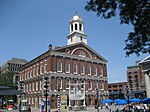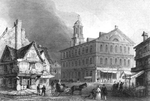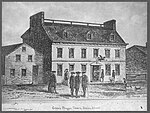Faneuil Hall
1743 establishments in MassachusettsAC with 0 elementsBoston National Historical ParkBuildings and structures in BostonCharles Bulfinch buildings ... and 9 more
Commercial buildings completed in 1762Commercial buildings on the National Register of Historic Places in MassachusettsEvent venues on the National Register of Historic Places in MassachusettsGovernment Center, BostonLandmarks in BostonMarket housesNational Historic Landmarks in BostonNational Register of Historic Places in BostonShopping malls in Massachusetts

Faneuil Hall ( or ; previously ) is a marketplace and meeting hall located near the waterfront and today's Government Center, in Boston, Massachusetts. Opened in 1743, it was the site of several speeches by Samuel Adams, James Otis, and others encouraging independence from Great Britain. It is now part of Boston National Historical Park and a well-known stop on the Freedom Trail. It is sometimes referred to as "the Cradle of Liberty", though the building and location have ties to slavery . In 2008, Faneuil Hall was rated number 4 in "America's 25 Most Visited Tourist Sites" by Forbes Traveler.
Excerpt from the Wikipedia article Faneuil Hall (License: CC BY-SA 3.0, Authors, Images).Faneuil Hall
Faneuil Hall Square, Boston
Geographical coordinates (GPS) Address Website Nearby Places Show on map
Geographical coordinates (GPS)
| Latitude | Longitude |
|---|---|
| N 42.36 ° | E -71.05625 ° |
Address
Project Management Academy
Faneuil Hall Square 4
02109 Boston
Massachusetts, United States
Open on Google Maps









